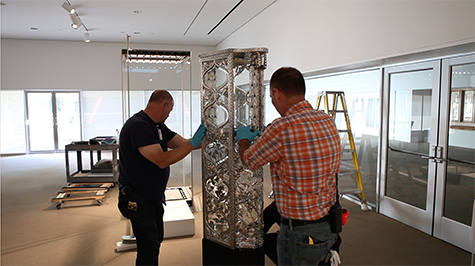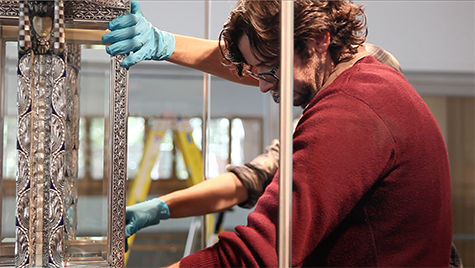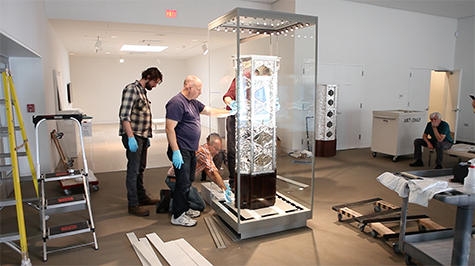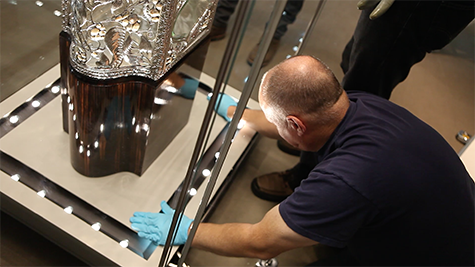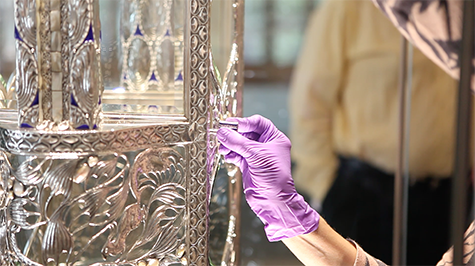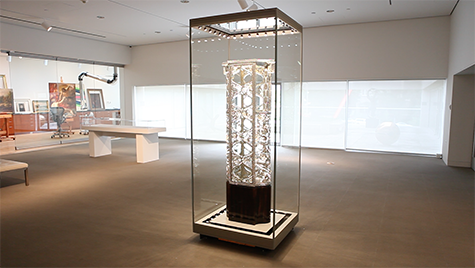
The Wittgenstein Vitrine (from the 1908 Vienna Kunstschau), 1908, Wiener Werkstätte (Vienna Workshops), Vienna, Austria, 1903-1932, maker; Carl Otto Czeschka, Austrian, 1878-1960, designer; Josef Berger, Austrian, 1874/75-?, goldsmith; Josef Hoszfeld, Austrian, 1869-1918, Adolf Erbrich, Austrian, 1874-?, Alfred Mayer, Austrian, 1873-?, silversmiths; Josef Weber, dates unknown, cabinetmaker; Wabak, Albrech, Plasinsky, Cerhan (unidentified craftsmen), silver, moonstone, opal, lapis lazuli, mother-of-pearl, baroque pearls, onyx, ivory, enamel, glass, and Macassar ebony veneers (replaced), Dallas Museum of Art, The Eugene and Margaret McDermott Art Fund, Inc.
With fall just around the corner, here’s a brief sneak peek into the conservation treatment, made possible through the Art Conservation Project grant from Bank of America, of the DMA’s recent acquisition, a masterpiece of Viennese design known as the Wittgenstein Vitrine.
An exhibition dedicated to this spectacular addition to the DMA’s collection, Modern Opulence in Vienna: The Wittgenstein Vitrine, opens November 15 in the Conservation Gallery. The display will examine the historical significance of the Wiener Werkstätte vitrine and include other examples of Viennese art and design from the period. It will also highlight the conservation treatment and technical analyses carried out during the past year.

Collaboration between curator and conservators – a discussion on original wooden base height, veneer, and finish

Fitting the new curved glass side panel, replacing a missing element
The elaborate silver vitrine (or display case) stands roughly five feet tall and is encrusted with pearls, lapis lazuli, opals, onyx, and other gemstones. Each of these materials requires different conservation approaches and solutions. The overarching goal of the treatment has been to bring the piece closer to its original 1908 appearance, as well as to stabilize a number of fragile elements. The most stunning transformation has resulted from the reduction of blackened tarnish and the removal of layers of old silver polish residue trapped within the intricate metalwork.

Detail of old polish residue trapped between glass and metalwork

Detail of old polish residue caught between the glass panes and silver decorative elements

Engaging in many painstaking hours of old polish removal and reduction of silver tarnish
Conservation treatments do not take place within a vacuum, and an exciting part of the project has been the interdepartmental collaboration between the curatorial, conservation (including myself), and collections staff at the DMA. Kevin W. Tucker, The Margot B. Perot Senior Curator of Decorative Arts and Design at the Dallas Museum of Art, and I have also been working with outside consultative experts, including silversmiths, specialty glassmakers, gemologists, research scientists, and even an ornithologist (to help identify the various birds depicted on the vitrine).

Detail of a pearl cluster with two birds. Notice the old polish residue in the interstices surrounding the cluster.

During removal of silver tarnish, as seen in this image from left to right.
Working almost daily on an intimate and intense level with an object has resulted in many discoveries, which we look forward to sharing with the public in both the exhibition and the opening symposium on November 15, 2014.
Fran Baas is the Associate Conservator of Objects at the DMA.
